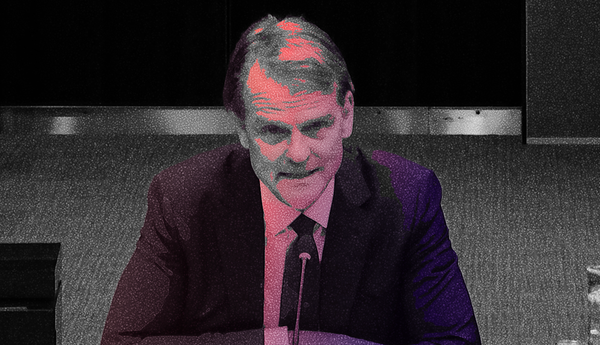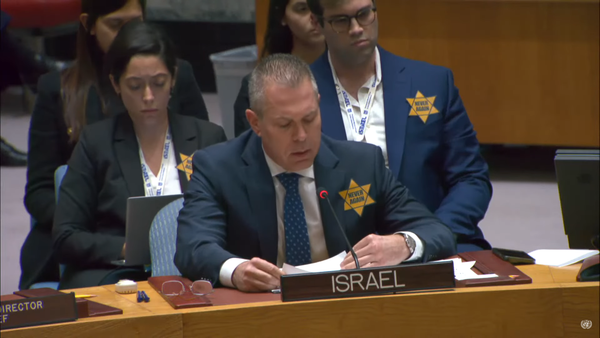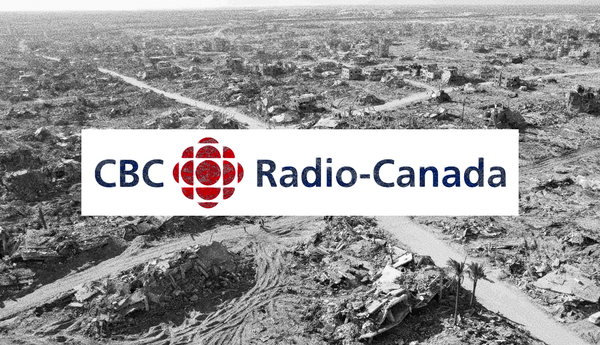Toward the beginning of the pandemic in Canada, some of those in positions of power and influence made an effort to at least appear to care about their customers or constituents, as well as the workers that would keep society functioning.
Some newspapers removed paywalls to articles dealing with the pandemic, framing it as an important public service for readers. Nurses were branded as superheroes, and people were encouraged to bang pots and pans together each night to show their appreciation. And, the sort of workers who were viewed as dispensable, and treated as such, before the pandemic, were suddenly referred to as “essential” or bravely serving on the “frontline.”
Of course, this trend was critiqued from the beginning by leftists who worried that this sort of discourse, while nice, might not lead to actual material improvements for the workers in question: wage increases, paid time off, enhanced safety measures, unemployment support, etc. They were right, as policies implemented on behalf of these workers were insufficient in terms of benefits offered, and too short in duration.
At some point, though, the media also seems to have gotten tired of viewing these workers as essential. Forget actually doing anything to help them — even referring to them in an appreciative manner was pushed off the table. Their jobs remained just as critical as before, but their status as “essential” or “frontline” workers all but disappeared.
I’ve done an analysis of the Toronto Star, National Post and Globe and Mail’s print editions from March 2020 to Jan. 17, 2022, to track the use of the phrases “frontline workers” and “essential workers.” I chose those three publications because the Post and Globe are Canada’s two national newspapers, and the Star has the largest circulation.
Before I go on to share my results, I should note I got this idea from Adam Johnson, a media critic in the United States that did a similar analysis of the New York Times. He publishes some of the best media criticism out there, so you should follow him on Twitter, subscribe to his Substack and check out the podcast he co-hosts, Citations Needed.
My analysis found that up until late 2021, the number of uses of “frontline workers” or “essential workers” in these three publications as a whole generally corresponded with the rate of hospitalizations in Canada from COVID-19 (calculated mid-month, per million people.) Johnson’s analysis of the Times came to a similar conclusion.
As hospitalizations peaked (and subsequently, lockdowns or closures of various sorts were implemented,) the media discussed those still working in more reverential terms. The reason, presumably, was that they were some of the only ones still having to put themselves at risk to get a paycheque, and providing services that others were now even more dependent on than before.
One major exception throughout this period, where references in articles far outweighed the hospitalization rate, was April 2021, which was largely due to Ontario debating paid sick leave for workers, and the federal government ending the Canada Emergency Response Benefit.
Starting in about September 2021 though, things started to shift dramatically in the other direction: hospitalizations increased and then skyrocketed, but the use of the phrase “essential workers” or “frontline workers” plummeted.
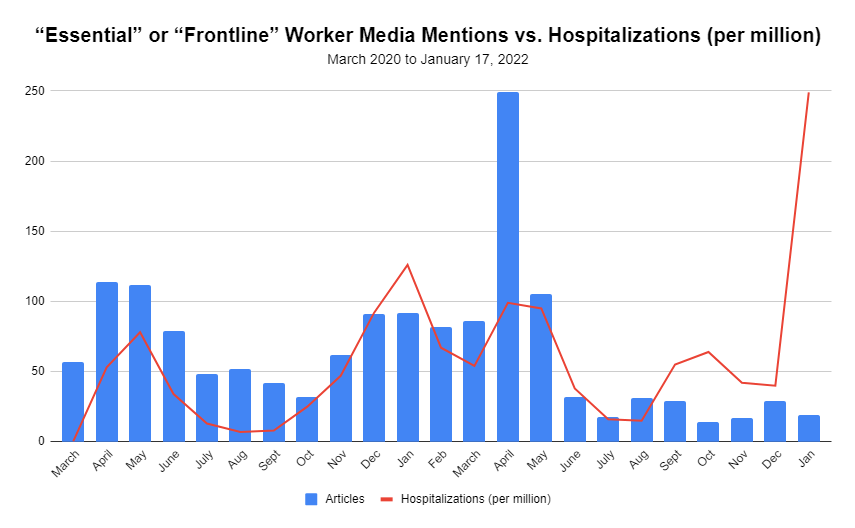
Of the 23 months I analyzed, the past four have had the lowest number of references to essential or frontline workers (with the exception of July 2021.) The prior three hospitalization peaks (May 2020, January 2021, April 2021) had 112, 126 and 249 mentions of these phrases respectively. Meanwhile, the two most recent peaks (October 2021, January 2022) have just 14 and 19 mentions respectively (though January is on track for about 40.) This month’s hospitalization rate was almost double the previous high (January 2021), and yet it has had just 22 per cent of the total “frontline” or “essential” mentions thus far.
Johnson, who got similar results, wrote, “Either the Times’ editorial focus has shifted away from the plight of frontline workers, or its editors have made a choice to use the label less when reporting on them.”
To get a sense of what the case may be here, I looked at what percentage of mentions of workers included “essential” or “frontline” as modifiers. I found that the most recent months had a lower percentage than almost any before, and are particularly low compared to the most recent hospitalization peaks. January and April 2021 had modifier percentages of 10 and 30 respectively, whereas October 2021 and this January had rates of 2.6 and 6.4 per cent respectively.
So: the number of articles mentioning workers is down; the use of the phrases “frontline workers” or “essential workers” is down; the percentage of mentions of “frontline” or “essential” as modifiers to “workers” is down. (I’ve included a graph below showing the decline of the number of mentions of “workers” in general in these publications throughout the pandemic.)
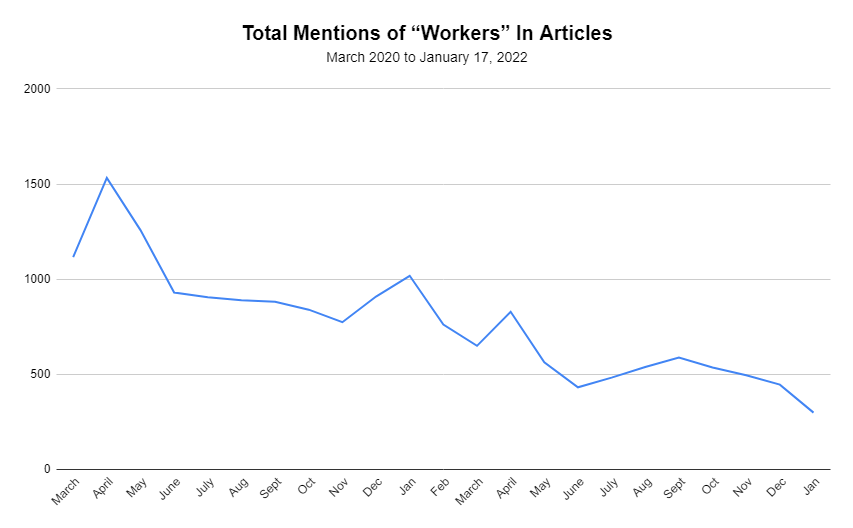
There are some differences from paper to paper. For example, the Toronto Star has both the largest number of articles mentioning “essential” or “frontline” (763, more than half the total) and the highest percentage (10.5 per cent) relative to mentions of workers overall. For comparison, the Globe’s numbers were 400 articles (7 per cent), and the Post’s just 329 (6 per cent.) In fact, since June 1, the Post has only used the phrase “essential workers” or “frontline workers” four times, compared to 128 for the Star and 57 for the Globe.
As far as I know, there has not been any directive given to stop using the terms, though of course this could have happened behind the scenes. This seems more likely at the Post, which in recent months has used its editorial space to rail against support for workers (“Liberals prolong incentives for workers to stay home, and businesses are suffering”; “COVID-income supports must end for the recovery to truly begin.”)
This reduction in the use of “essential” and “frontline” comes amidst a broader shift away from measures intended to blunt the impact of the worst of the pandemic. Political leaders are now effectively demanding things go back to normal, despite the continued risk.
For example, Ontario has changed the mandated isolation period post-COVID infection from 10 to five days, to the applause of the Retail Council of Canada. The same thing has happened in Saskatchewan, New Brunswick, Manitoba, Quebec, British Columbia and Alberta. Testing has been limited to a narrow range of people. Rent increases have been reimplemented. Emergency pay measures have long been cut. Federal supports have gotten less generous and more means tested. The examples go on.
The labour of these workers is as essential as ever, but those in charge have decided treating it that way is too expensive. It’s unfortunate news media has followed suit, making it even easier for those in charge to ensure workers come out of the pandemic treated just as poorly as they were before.




